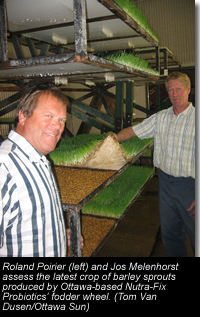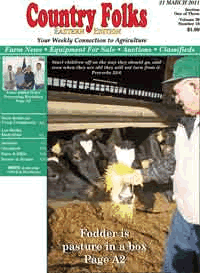
"New cattle feed system sprouts up in Valley" By
Tom Van Dusen, Ottawa Sun
Instead of alfalfa, the plants produced by Roland Poirier’s revolutionary fodder wheels are coarser, thicker barley spouts which cows search out like candy. Ottawa-based Poirier owns Nutra-Fix Probiotics, which has installed wheels at farms in Chesterville, Avonmore and northern New York State. He recently received an order for 12 units going to two organic farms in Vermont, where some of his parts are made. They’re slated to be up and running by April 1. Earlier this year, Jos and Francine Melenhorst, who operate a dairy farm near Chesterville, bought one Nutra FX Nutra Culture unit, a 16-ft. long, 12-ft. square assembly of steel supports and trays which slowly rotates barley seed on a timer system, providing light and treated, temperature-controlled water. The system converts the seed into thick carpets of nutritious sprouts within six days, at a rate of up to 800 lbs. a day when at peak performance. The fresh sprouts are mixed into the feed ration, replacing much of the grain component. The perfect core daily diet per cow, Poirier says, is about 14 lbs. of sprouts along with 12 lbs. of high-moisture corn, 5 lbs. of roasted soybeans, and 80 lbs. of hay. Poirier claims that among the many benefits of feeding sprouts, it reduces incidences of acidosis because, with less grain in the mix, the rapid fermentation process and amount of acid required to digest are eased. In addition to enhanced animal health, lower installation costs than the average silo, and decreased grain costs, he cites other benefits such as reduced veterinary and hoof trimming fees, increased conception, and lower herd cull rates. Higher protein content The one major drawback is that mould can appear if the wheel process isn’t managed properly, which means adhering to the six-day seed-to-feed cycle, something fodder wheel owners should aim for anyway because nutritional levels are at their highest at the six-day mark. While milk production is about the same, the Melenhorsts say both their protein and butterfat content are up. They say their cows have become more contented since the fodder wheel went to work and actually search out as a special treat barley sprout chunks in the ration. “They love it,” Jos said. “They can’t get enough of it.” The Melenhorst decided to try out the wheel after one of their two silos toppled in a storm earlier this year. Instead of forking over $75,000 for a new silo all-in, the couple spent $20,000 less for a fodder wheel, technology imported from Australia and adapted by Poirier. In a related sideline, Poirier and his wife Theresa are leaders of a church-based charity called You Feed Them (YFT), which is toiling to improve food production in Kenya. In connection with YFT, a fodder wheel will be installed in a Kenyan community early in the new year, with Poirier providing the equipment at cost and overseeing the project. To help raise $7,000 outstanding to cover the wheel, Trinity Bible Church in Osgoode is holding a dinner/auction Nov. 5 starting at 6:30 p.m. “In Africa, the fodder wheel will have the double benefit of congregating the livestock in one place, where manure can be collected to use as a natural fertilizer for the crops,” Poirier said. “There are almost no nutrients in the soil there.” Link to above article on Ottawa Sun website |
| Eastern
Ontario AgriNews -
May 2011, Vol.35, No.5
Ottawa-based NutraFx has sold a pair of the new "nutraculture wheels" to the Stormont County producer, according to company founder Roland Poirier, each one capable of generating 1,200 pounds of sprouts daily from 120 pounds of barley seed. "Nutraculture is the age-old practice of growing barley sprouts," said Roland, whose firm began rolling out the systems April 1. Varying in price from $23,500 to $26,500 (not including the necessary heated building that roughly doubles the cost), the units are 12 feet wide and slightly resemble the paddle wheels on an old-fashioned Mississippi river boat. Instead of paddles, there are large panel trays that contain the seed, which slowly rotate through a spray nozzle mist of water on the downswing. A one-quarter horsepower motor drives the works. Six-days of staggered production rests on the unit at any given time, as it takes that long for a tray of seed to turn into luscious green shoots of the desired eight-inch length. The system’s key benefits for the farmer are lower feed costs and improved herd health - in addition to being a less environmentally intensive crop than typical corn or other grain feed supplements, said Poirier. He said a New York state farmer who recently installed two wheels realized a payback of just six months. A 100-head milking herd would require the equivalent of 12 to 16 acres of barley seed to supply a pair of wheels for 2,400 pounds of daily sprout output - while effectively displacing a much larger corn acreage. One wheel is said to displace 30 acres of regular corn or grain production in the feed ration. This then allows the farmer to grow more alfalfa for feed; Poirier also recommends adding some of the leftover barley straw to the mix, to ensure adequate fibre in the animals’ diet. The actual sprouts themselves are 99 per cent digestible, he said, compared to the 68 per cent digestibility of the corn they replace. "Corn is really too valuable to be feeding to cows anyway," he asserted. The sprouts also reduce acidity in the cow’s gut and eliminate the need for all supplements - except for soybeans. NutraFX recommends 2.5 kg beans daily per cow within the revamped ration. As part of the system, the farmer is supplied with an Apple iPad, which allows Poirier to remotely monitor the operation to ensure maximum output and measure system benefits across the operation. NOTE: Follow-up article to follow, complete with photos once unit is installed at the farm location. Link to above article on Eastern Ontario AgriNews website Country
Folks Article - March 21, 2011
Wilson is currently producing his fodder in a Fodder Solutions unit. He plans to install two more indoor units. One of those units will be Wilson’s own invention, Nutra-Culture “The Queen Mary Paddle Wheel,” based on the ferris wheel design. “This is a five-ton building once we get all the systems in operation.” They will have all three models in operation in the building by spring. “We have had lots of ideas come to mind and our curiosity drives us to continuously investigate new concepts with our fodder,” indicated Wilson. For example, although the fodder system was designed to use chlorine treated water, Wilson experimented and found that the fodder yield increased when he used other solutions. Wilson used his farmer ingenuity and found that his iodine based formulation effectively treated the water but did not inhibit growth. Wilson findings increased 300 pounds of growth in the six-day cycle. After other modifications, Wilson has the unit, which was designed to produce 1,200 pounds per day, yielding about 1,800 pounds now. It was originally designed to be outside. But in order to control growth and focus on production experimentation, he decided to move the unit inside a building. Found fodder Wilson’s farm’s inclusion of fodder happened because Wilson was looking to improve his operation. Despite being able to average as much as 112 pounds per cow per day, Wilson has always wanted to do better. “It goes back seven years when we were feeding a probiotic product from Nutrafix. We started sampling the manure with the idea we would remove those things from the cow’s diet that she wasn’t using. While on a company trip to California, I learned of the concept that was first used as ‘culture’ back in the 1860s. The concept fit our farm’s mission.” Once Ken returned from the trip, his father John agreed that they needed to purchase a system and try it at their northern New York dairy farm. “It’s a bad time to be retiring. While it was a $40,000 investment, the unit produces feed every day unlike some of my other equipment. This is an exciting technology. With it, we are feeding the roots,” stated John Wilson. How it works The system provides light and water on a timer system. Irrigation line is attached above each tier of trays and growth lights are stationed throughout the chamber. As needed the system automatically irrigates the 80 degree mildly treated water to three tiers of sprouts each hour so that the temperature is not drastically reduced within the chamber. A fan circulated the air within the chamber. Each day, the most mature trays are emptied from the end of the system and then new trays are added at the other end which in turn pushes the next oldest trays to the just emptied other end. Each tray holds five pounds of barley seed that will yield 50 as-fed pounds of fodder on day six. Six days is the ideal amount of growth because a mold will develop in the top of the mass. There are other fodder producers that are chemically treating the sprouts so that they can grow them for seven or eight days, but the Wilsons have decided to produce a more organic product. Even better: cows do crave it Opening a feed alley door on a cold winter day doesn’t often motivate a barn full of cows to get up and come to the feed bunk. But animals from either side of the barn noticably made their way towards the Wilsons with their 50 pound panel of fodder which clearly demonstrated the high palatability of the feed. A recent forage analysis reported the fresh barley forage as 11.1 percent dry matter, 16.1 percent crude protein, 22.9 percent acid detergent fiber, 39 percent neutral detergent fiber, 16.5 percent starch, 18.7 percent simple sugars and 22.9 percent water soluble carbohydrates. “We recently nursed a sick cow that we thought we may have to put down back into the herd on the fodder. We are finding that chopped feeds have an acid pH while the barley sprout is an alkaline. We are also learning that grain hulls contain a colostrum-like compound that is high in conjugated linoleic acids (CLA) that helps the developing sprout. This could be part of the benefit to our cows,” offered Wilson. Measuring results Prior to feed fodder, the Wilsons were known for high milk production. For the last five years they have averaged at least 90 pounds of production per cow. “High milk production is driven by our forage program. Now on fodder, herd production dropped to around 78 pounds per cow, the grain fed per cow dropped from about 28 pounds down to eight pounds now.” “We measure everything here. We are focusing on our Income Over Feed Cows, Income per cow and herd efficiency areas such as cull rate and the breeding program. We also noticed that we are dealing with about 20 percent less manure. Basically we are feeding more forages so our feed program consists of more of what we produce here on our farm. Our goal is to have enough fodder to feed 50 pounds per cow and to produce 80 pounds of milk despite being fed no purchased grain,” stated Wilson. “While we tried and found that our cows liked buckwheat and sunflowers, our current production unit had sunflower hulls all over the inside of it. Nothing ventured, nothing gained,” grinned Wilson. “We liked tricale and peas with the high sugars yield but that combination seemed to promote mold growth. We think we might try rice in the near future,” indicated Wilson. Having seen an improvement in cow health and cost of production, Wilson is happy with the decision to use fodder. Wilson is now responding to weekly international calls from people interested in fodder. “This endeavor has become a new chapter in my farming career,” concluded Wilson. Ken Wilson can be reached at kwilson2563@yahoo.com
|
'© All
website information and content is copyright protected, and is the
property of Nutra-Fix. Reproduction and use by permission only.'


 After
making the $40,000 investment in the fodder growth chamber,
the Wilsons have consistently added fodder to the milk
cow diet and reduced the amount of off farm feed purchases.
After greatly improving an off cow with fodder, the Wilsons
now call their fodder production unit “Pasture in
a Box.”
After
making the $40,000 investment in the fodder growth chamber,
the Wilsons have consistently added fodder to the milk
cow diet and reduced the amount of off farm feed purchases.
After greatly improving an off cow with fodder, the Wilsons
now call their fodder production unit “Pasture in
a Box.”